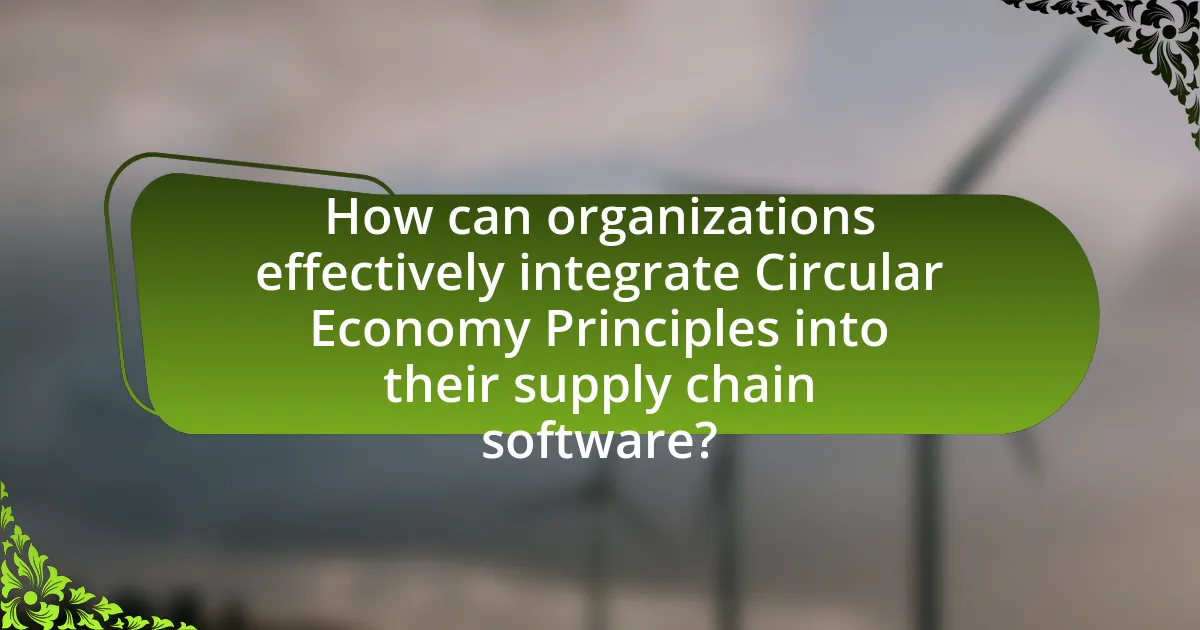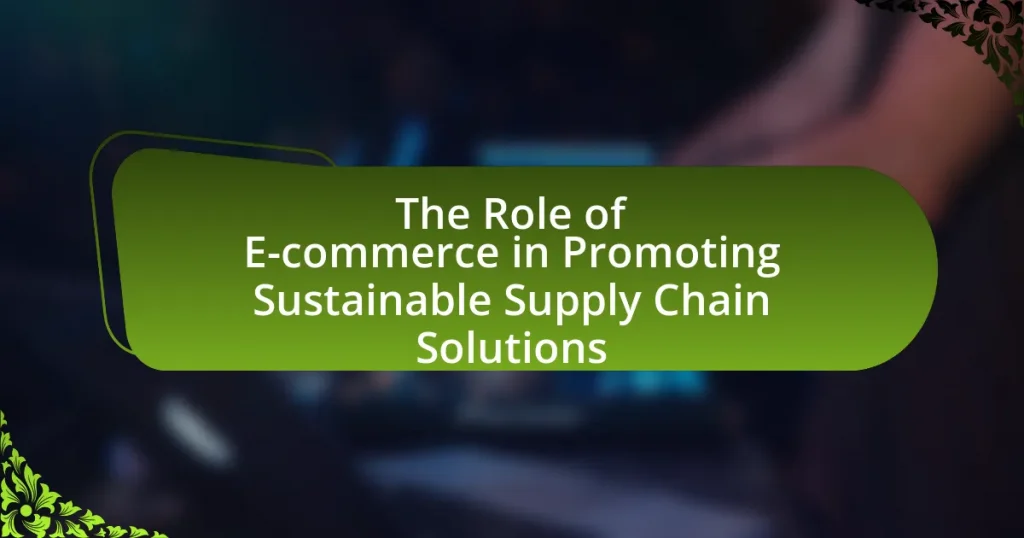The article focuses on best practices for integrating circular economy principles into supply chain software, emphasizing the importance of minimizing waste and maximizing resource efficiency. It outlines key components of circular economy practices, such as designing for longevity, promoting reuse and recycling, and implementing closed-loop systems. The article also discusses the differences between circular and traditional supply chain practices, the challenges organizations face during integration, and the role of technology and data analytics in facilitating this transition. Additionally, it highlights the significance of stakeholder engagement, training, and continuous improvement in achieving successful integration of circular economy principles.

What are Circular Economy Principles in Supply Chain Software?
Circular economy principles in supply chain software focus on minimizing waste and maximizing resource efficiency throughout the supply chain lifecycle. These principles include designing for longevity, promoting reuse and recycling, and implementing closed-loop systems that allow materials to be continuously cycled back into production. For instance, software solutions can facilitate tracking of materials, enabling businesses to identify opportunities for recycling and reducing reliance on virgin resources. Research indicates that companies adopting circular economy practices can reduce costs by up to 30% while also decreasing their environmental impact, demonstrating the effectiveness of these principles in enhancing sustainability and operational efficiency.
How do Circular Economy Principles differ from traditional supply chain practices?
Circular Economy Principles focus on resource efficiency and sustainability, contrasting with traditional supply chain practices that prioritize linear production and consumption. In a circular economy, the aim is to minimize waste and maximize the lifecycle of products through reuse, recycling, and regeneration, whereas traditional supply chains often follow a “take-make-dispose” model, leading to significant waste generation. For instance, according to the Ellen MacArthur Foundation, transitioning to a circular economy could reduce global greenhouse gas emissions by 39% by 2030, highlighting the environmental benefits of this approach compared to conventional practices.
What are the key components of Circular Economy Principles?
The key components of Circular Economy Principles include designing for longevity, promoting resource efficiency, and enabling product life extension. Designing for longevity ensures products are created to last longer, reducing waste and resource consumption. Promoting resource efficiency involves optimizing the use of materials and energy throughout the product lifecycle, which minimizes environmental impact. Enabling product life extension focuses on maintaining and repairing products to extend their usability, thereby reducing the need for new resources. These components collectively contribute to a sustainable economic model that prioritizes environmental health and resource conservation.
Why is it important to integrate these principles into supply chain software?
Integrating circular economy principles into supply chain software is crucial for enhancing sustainability and operational efficiency. These principles promote resource optimization, waste reduction, and the creation of closed-loop systems, which can lead to significant cost savings and improved environmental impact. For instance, a study by the Ellen MacArthur Foundation found that adopting circular economy practices could generate $4.5 trillion in economic benefits by 2030. This integration not only aligns with regulatory requirements but also meets growing consumer demand for sustainable practices, thereby improving brand reputation and competitiveness in the market.
What challenges do organizations face when integrating Circular Economy Principles?
Organizations face several challenges when integrating Circular Economy Principles, primarily including a lack of understanding and awareness of these principles among stakeholders. This knowledge gap can hinder effective implementation, as employees and management may not fully grasp the benefits or methods of transitioning to a circular model. Additionally, organizations often encounter difficulties in redesigning existing processes and supply chains to accommodate circular practices, which may require significant investment in new technologies and systems.
Moreover, regulatory and compliance issues can pose obstacles, as existing laws may not support circular initiatives or may create barriers to innovation. Financial constraints also play a critical role, as organizations may struggle to allocate sufficient resources for the transition. Lastly, measuring the impact and success of circular initiatives can be complex, making it challenging for organizations to justify their investments and efforts.
How can organizations overcome resistance to change?
Organizations can overcome resistance to change by actively engaging employees in the change process and providing clear communication about the benefits of the change. Research indicates that when employees are involved in decision-making and understand how changes align with organizational goals, they are more likely to support the transition. For instance, a study by Kotter International found that organizations that effectively communicated the vision for change experienced a 70% success rate in implementing new initiatives. Additionally, offering training and support can help alleviate fears and build confidence among employees, further facilitating acceptance of change.
What technological barriers exist in the integration process?
Technological barriers in the integration process include data silos, lack of interoperability, and inadequate infrastructure. Data silos occur when information is isolated within different systems, preventing seamless communication and data sharing. Lack of interoperability arises when various software solutions cannot effectively communicate or exchange data due to differing standards or protocols. Inadequate infrastructure refers to insufficient technological resources, such as outdated hardware or software, which can hinder the implementation of new systems necessary for integrating circular economy principles into supply chain software. These barriers can significantly impede the efficiency and effectiveness of integration efforts.

How can organizations effectively integrate Circular Economy Principles into their supply chain software?
Organizations can effectively integrate Circular Economy Principles into their supply chain software by incorporating features that promote resource efficiency, waste reduction, and product lifecycle management. This can be achieved through the implementation of data analytics tools that track resource usage and waste generation, enabling organizations to identify areas for improvement. For instance, software can facilitate the design of products for longevity and recyclability, aligning with circular economy goals. Additionally, integrating supplier collaboration platforms can enhance transparency and foster partnerships focused on sustainable practices. Research indicates that companies adopting circular economy strategies can reduce costs by up to 30% while improving their environmental impact, demonstrating the effectiveness of these software integrations.
What steps should be taken to initiate the integration process?
To initiate the integration process of circular economy principles into supply chain software, organizations should first conduct a comprehensive assessment of their current supply chain practices. This assessment identifies areas where circular economy principles can be applied, such as waste reduction, resource efficiency, and product lifecycle management. Following the assessment, organizations should define clear objectives and key performance indicators (KPIs) that align with circular economy goals. Next, they should engage stakeholders across the supply chain to ensure buy-in and collaboration, facilitating a shared understanding of the integration process. Finally, organizations should develop a detailed implementation plan that outlines the necessary technological adaptations, training requirements, and timelines for integrating circular economy principles into their supply chain software.
How can stakeholder engagement be facilitated during integration?
Stakeholder engagement can be facilitated during integration by implementing structured communication strategies and collaborative decision-making processes. Establishing regular meetings and feedback loops ensures that stakeholders are informed and can contribute their insights, which enhances transparency and trust. Research indicates that organizations that actively involve stakeholders in the integration process experience higher satisfaction and commitment levels, as evidenced by a study published in the Journal of Business Research, which found that inclusive practices lead to improved project outcomes and stakeholder relationships.
What role does training play in successful integration?
Training is essential for successful integration of circular economy principles into supply chain software. It equips employees with the necessary skills and knowledge to effectively implement and utilize new systems that support sustainable practices. Research indicates that organizations that invest in comprehensive training programs experience a 30% increase in employee performance and a 25% reduction in integration time, demonstrating the direct impact of training on operational efficiency and adaptability.
What tools and technologies support the integration of Circular Economy Principles?
Tools and technologies that support the integration of Circular Economy Principles include digital platforms for resource tracking, lifecycle assessment software, and blockchain technology. Digital platforms enable businesses to monitor resource usage and waste, facilitating efficient resource management. Lifecycle assessment software helps organizations evaluate the environmental impacts of products throughout their lifecycle, promoting sustainable design. Blockchain technology enhances transparency and traceability in supply chains, ensuring that materials are sourced responsibly and reused effectively. These tools collectively enable companies to adopt circular practices, reduce waste, and optimize resource utilization.
Which software solutions are best suited for this purpose?
Software solutions best suited for integrating circular economy principles into supply chain management include SAP S/4HANA, Oracle SCM Cloud, and Microsoft Dynamics 365 Supply Chain Management. These platforms provide comprehensive tools for tracking resource usage, optimizing waste management, and enhancing product lifecycle management. For instance, SAP S/4HANA offers advanced analytics and real-time data processing, enabling companies to make informed decisions that align with circular economy goals. Oracle SCM Cloud features robust sustainability metrics, allowing organizations to measure and improve their environmental impact. Microsoft Dynamics 365 integrates seamlessly with IoT devices, facilitating efficient resource tracking and waste reduction. These solutions are validated by their widespread adoption among leading companies aiming to enhance sustainability in their supply chains.
How can data analytics enhance the integration process?
Data analytics can enhance the integration process by providing actionable insights that streamline decision-making and optimize resource allocation. By analyzing data from various sources, organizations can identify inefficiencies and areas for improvement within their supply chain, leading to more effective integration of circular economy principles. For instance, a study by McKinsey & Company found that companies leveraging data analytics in their supply chains can reduce operational costs by up to 15% and improve service levels by 20%. This demonstrates that data-driven strategies not only facilitate smoother integration but also contribute to overall sustainability goals.

What are the best practices for maintaining Circular Economy Principles in supply chain software?
The best practices for maintaining Circular Economy Principles in supply chain software include implementing data-driven decision-making, fostering collaboration among stakeholders, and utilizing lifecycle assessment tools. Data-driven decision-making enables organizations to optimize resource use and minimize waste by analyzing consumption patterns and material flows. Collaboration among stakeholders, including suppliers, manufacturers, and consumers, enhances transparency and encourages shared responsibility for sustainability. Utilizing lifecycle assessment tools allows companies to evaluate the environmental impact of products throughout their lifecycle, facilitating informed choices that align with circular economy goals. These practices collectively support the transition to a circular economy by promoting resource efficiency and reducing environmental impact.
How can continuous improvement be ensured in the integration process?
Continuous improvement in the integration process can be ensured by implementing regular feedback loops and performance metrics. Establishing a framework for ongoing evaluation allows organizations to identify inefficiencies and areas for enhancement. For instance, utilizing key performance indicators (KPIs) related to resource utilization and waste reduction can provide measurable insights into the effectiveness of circular economy principles in supply chain software. Additionally, fostering a culture of collaboration among stakeholders encourages the sharing of best practices and innovative solutions, further driving continuous improvement.
What metrics should be used to measure success?
To measure success in integrating circular economy principles into supply chain software, key metrics include resource efficiency, waste reduction, and lifecycle impact. Resource efficiency can be quantified by measuring the percentage of materials reused or recycled within the supply chain, which directly reflects the effectiveness of circular practices. Waste reduction can be assessed through the total waste generated per unit of product, indicating improvements in minimizing waste outputs. Lifecycle impact can be evaluated using life cycle assessment (LCA) metrics, which analyze the environmental impacts of products from cradle to grave, providing a comprehensive view of sustainability efforts. These metrics collectively offer a robust framework for assessing the success of circular economy initiatives in supply chains.
How can feedback loops be established for ongoing refinement?
Feedback loops can be established for ongoing refinement by implementing continuous data collection and analysis mechanisms within supply chain software. This involves regularly gathering performance metrics, customer feedback, and operational data to identify areas for improvement. For instance, utilizing real-time analytics tools allows organizations to monitor key performance indicators (KPIs) and adjust processes accordingly. Research indicates that companies employing data-driven decision-making can enhance operational efficiency by up to 5-6% annually. By integrating these feedback mechanisms, organizations can create a dynamic system that promotes iterative improvements aligned with circular economy principles.
What common pitfalls should organizations avoid during integration?
Organizations should avoid inadequate stakeholder engagement during integration. Failing to involve key stakeholders can lead to misalignment of goals and resistance to change, ultimately undermining the integration process. Research indicates that successful integration requires collaboration across departments, as highlighted in a study by the Project Management Institute, which found that projects with high stakeholder engagement are 20% more likely to succeed. Additionally, organizations should steer clear of neglecting data quality, as poor data can result in flawed decision-making and operational inefficiencies. According to a report by Gartner, organizations that prioritize data governance see a 30% improvement in integration outcomes. Lastly, organizations must not overlook the importance of training and support for users, as inadequate training can lead to low adoption rates and ineffective use of new systems.
How can misalignment with business goals be prevented?
Misalignment with business goals can be prevented by ensuring continuous communication and alignment between stakeholders throughout the project lifecycle. Regular meetings and updates facilitate the sharing of objectives, progress, and challenges, which helps to keep all parties focused on the same goals. Research indicates that organizations with strong communication practices are 25% more likely to achieve their strategic objectives, highlighting the importance of this approach in maintaining alignment.
What are the risks of inadequate stakeholder communication?
Inadequate stakeholder communication poses significant risks, including project delays, misalignment of objectives, and increased costs. When stakeholders are not effectively informed, misunderstandings can arise, leading to conflicting priorities and wasted resources. For instance, a study by the Project Management Institute found that poor communication contributes to 57% of project failures, highlighting the critical need for clear and consistent dialogue among all parties involved. Additionally, lack of communication can result in diminished stakeholder trust and engagement, ultimately jeopardizing the success of initiatives aimed at integrating circular economy principles into supply chain software.
What practical tips can organizations implement for successful integration?
Organizations can implement several practical tips for successful integration of circular economy principles into supply chain software. First, they should conduct a thorough assessment of existing processes to identify areas where circular economy practices can be integrated, such as waste reduction and resource efficiency. This assessment can be supported by data analytics to quantify potential improvements.
Next, organizations should engage stakeholders across the supply chain, including suppliers and customers, to foster collaboration and ensure alignment on circular economy goals. Effective communication and training programs can enhance understanding and commitment to these principles among all parties involved.
Additionally, organizations should invest in technology that supports circular economy initiatives, such as software that tracks resource usage and waste generation. This technology can provide real-time insights, enabling organizations to make informed decisions that promote sustainability.
Finally, organizations should establish clear metrics to measure the success of integration efforts, such as reductions in waste or increases in recycled materials used. Regularly reviewing these metrics can help organizations adjust their strategies and ensure continuous improvement in their circular economy practices.



